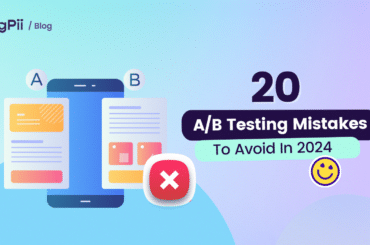Did you know that 70% of online sales originate from category pages?
That stat alone is proof that you should never ignore testing category pages. If anything, they are one of the critical funnel pages on your e-commerce website.
Time and time again, we’ve noticed that usability hurdles on category pages can affect your e-commerce conversion rate.
On the flip side, a well-optimized category page can help improve your customers’ shopping experience, which, therefore, boosts the conversion rates of your online store.
According to research unveiled at SMX West 2020, which surveyed more than 30 of the top e-commerce websites, category pages outperformed product pages in 27 out of the 30 sites.
The research found that category pages had 413% more estimated traffic and 32% more traffic potential.
So, again, why are they vital in e-commerce websites?
The following goals will answer this question:
What’s the Goal of Category Pages?
Understanding the goals behind each web page on your e-commerce site will help you optimize them better.
And category pages are a critical piece of the puzzle; they can either be a conversion bottleneck or help increase conversions on your site.
So, understanding the purpose behind category pages will help you know what to A/B test exactly, why you need to A/B test, and what to do with your test results.
According to Anwar Aly, a CRO Specialist from Invesp, category pages have many goals, including:
1. They exist to make it easier for users to find the products they are looking for. That’s why they divide the products available on the website into groups.
2. The main use for category pages is that users can scan products with similar attributes to compare them, filter them, and have an eagle-eye view.
Also, I learned recently that one of the important goals of category pages is that they are great for SEO.
3. Your website content helps search engines understand what the pages on your site are about.
So, for e-commerce websites, when category pages have informative and good quality copies, search engines will understand the purpose of your pages and accordingly serve your buyer personas.
Why Should You A/B Test the Category Pages?
Every single page on any e-commerce website, whether it is a homepage, product page, category page, cart page, etc., is designed to make visitors perform a certain action.
A/B testing helps optimize these pages to do their designated actions, thereby improving the customers’ shopping experience and increasing the conversion rate.
According to Anwar, the main reasons why you should optimize and A/B test your category pages is to:
- Drive more users to your product pages.
He explained more by saying:
All the elements you can A/B test on your category pages – such as adding better filters, adding more options to products, highlighting more features and benefits to them, removing price, adding colors, etc – are hooking methods to get users to move to PDP.
- Provide users with a better flow to navigate through the products and find the right ones they are looking for without going through all of the website products.
- Make sure that users can compare different products with the same attributes and category.
By giving them, for example, different filtration options like color, size, price range, etc.
Or giving them sorting options, like date, best selling products, lowest or highest price, etc.
- Increase category to product detail page rate, which is the percentage of navigation from the category page to the product page.
For example, A/B testing different image styles on category pages can cause a massive uplift in this rate.
Worth mentioning that the average category to product detail page in the e-commerce industry is 50%.
- Also, A/B testing on category pages helps deliver the right amount of information without being too much.
This means not having too much content to distract the users from moving to the next stage (PDPs) but enough to encourage them to click on the products displayed.
Anwar adds:
Sometimes, websites add all sorts of information simultaneously to the category pages, making them crowded, confusing to users, and hard to scan. That’s why users might tend to neglect these pages.
Metrics to Focus On While Optimizing Category Pages
1- Conversion rate (category to order confirmation)
This metric measures how good your category pages are in persuading visitors to place an order.
CLP CR = The number of conversions / The number of sessions to the category pages.
2- Pre-product page abandonment rate (PPAR)
PPAR is the rate of customers abandoning the site at the category level before making it to the product pages.
3- Category to product page flow
It measures the rate at which customers flow from category page(s) to the product page(s).
4- Bounce rate
Bounce rate tracks the percentage of visitors that land on the category page and then leave without navigating to any other pages.
5- Exit rate
Exit rate measures the number of visitors who left your site after landing on the category page and compares it to the total number of views the page got.
6- Dwell time
Dwell time refers to the length of time a visitor spends looking at a webpage after clicking on a SERP page link before going back to the SERP results.
4 Examples of A/B Tests on Category Pages
According to Anwar, category pages have various elements that can be A/B tested. Here are some examples:
1- Grid view vs. list view
The idea behind testing grid view vs. list view is to try and improve how visitors view products on category pages. For some websites, grid views work best, while viewing is the better option on other lists.
On one of our clients in the e-commerce clothing space, we added an option for the users to enlarge product pictures on category pages (1 product in each row instead of 2).
In the above example, there was an uplift in conversion rate by 13.5%.
2- Product filters
The more filtering options you can provide customers with, the better. It is an effective method for increasing the success of your product category page.
We redesigned the filtration section for a better user experience, making it sticky on the top.
On this test, there was an uplift in conversion rate by 2.26%.
3- Showing product options
The importance of A/B testing filtering/sorting options is that you should consider them on your category pages.
For the same client, we added an option for users to choose product colors from the category pages, which also updates the product color in the image for a quick view of each color.
On this test, there was an uplift in conversion rate by 11.79%.
4- Highlighting perks
Highlighting your brand’s perks on category pages can help you increase your customers’ loyalty.
For example, when we showcased the loyalty program the website has on the category pages, it raised usability and got more email sign-ups.
On this test, there was an uplift of 3.47%.
Wrapping Things Up
This blog focused on some of the winning examples we did for some of our clients. However, there are so many things you can A/B test on category pages, such as:
- Emphasizing discounted items.
- Type of images (product images vs. lifestyle images).
- Experimenting with category naming conventions.
- Using personalization to display relevant categories.
- Auto filing options for your product search.
- Visibility of customer reviews.
- Hover effects for product thumbnails.
- Filtering and sorting options.
- Adding tags on product preview images.
Now, let’s summarize the lessons learned from this blog:
- The importance of category pages for e-commerce stores.
- Why you should test category pages.
- The important metrics to use while optimizing them.
- Some examples of A/B tests that we launched on category pages of different websites.



